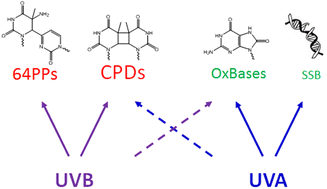当前位置:
X-MOL 学术
›
Photochem. Photobiol. Sci.
›
论文详情
Our official English website, www.x-mol.net, welcomes your feedback! (Note: you will need to create a separate account there.)
Formation of UV-induced DNA damage contributing to skin cancer development†
Photochemical & Photobiological Sciences ( IF 3.1 ) Pub Date : 2018-01-24 00:00:00 , DOI: 10.1039/c7pp00395a Jean Cadet 1, 2, 3, 4, 5 , Thierry Douki 6, 7, 8, 9, 10
Photochemical & Photobiological Sciences ( IF 3.1 ) Pub Date : 2018-01-24 00:00:00 , DOI: 10.1039/c7pp00395a Jean Cadet 1, 2, 3, 4, 5 , Thierry Douki 6, 7, 8, 9, 10
Affiliation

|
UV-induced DNA damage plays a key role in the initiation phase of skin cancer. When left unrepaired or when damaged cells are not eliminated by apoptosis, DNA lesions express their mutagneic properties, leading to the activation of proto–oncogene or the inactivation of tumor suppression genes. The chemical nature and the amount of DNA damage strongly depend on the wavelength of the incident photons. The most energetic part of the solar spectrum at the Earth's surface (UVB, 280–320 nm) leads to the formation of cyclobutane pyrimidine dimers (CPDs) and pyrimidine (6–4) pyrimidone photoproducts (64PPs). Less energetic but 20–times more intense UVA (320–400 nm) also induces the formation of CPDs together with a wide variety of oxidatively generated lesions such as single strand breaks and oxidized bases. Among those, 8–oxo–7,8–dihydroguanine (8–oxoGua) is the most frequent since it can be produced by several mechanisms. Data available on the respective yield of DNA photoproducts in cells and skin show that exposure to sunlight mostly induces pyrimidine dimers, which explains the mutational signature found in skin tumors, with lower amounts of 8–oxoGua and strand breaks. The present review aims at describing the basic photochemistry of DNA and discussing the quantitative formation of the different UV–induced DNA lesions reported in the literature. Additional information on mutagenesis, repair and photoprotection is briefly provided.
中文翻译:

紫外线诱导的DNA损伤的形成促进皮肤癌的发展†
紫外线引起的DNA损伤在皮肤癌的起始阶段起着关键作用。当未修复或细胞凋亡无法消除受损细胞时,DNA损伤会表现出突变性,从而导致原癌基因激活或肿瘤抑制基因失活。化学性质和DNA损伤的数量在很大程度上取决于入射光子的波长。在地球表面(UVB,280-320 nm)处,太阳光谱中能量最高的部分导致形成环丁烷嘧啶二聚体(CPD)和嘧啶(6-4)嘧啶酮光产物(64PPs)。较低的能量,但强度较高的UVA(320-400 nm)是20倍,也会诱导CPD的形成以及各种氧化产生的损伤,例如单链断裂和氧化碱基。其中8–oxo–7,8–二氢鸟嘌呤(8–oxoGua)是最常见的,因为它可以通过多种机制产生。有关细胞和皮肤中DNA光产物各自产量的可用数据表明,暴露于阳光下主要诱导嘧啶二聚体,这解释了皮肤肿瘤中发现的突变特征,其中8-oxoGua和链断裂的含量较低。本综述旨在描述DNA的基本光化学,并讨论文献中报道的不同的UV诱导的DNA损伤的定量形成。简要介绍了有关诱变,修复和光保护的其他信息。这解释了在皮肤肿瘤中发现的突变特征,其中8-oxoGua和链断裂的含量较低。本综述旨在描述DNA的基本光化学,并讨论文献中报道的不同的UV诱导的DNA损伤的定量形成。简要介绍了有关诱变,修复和光保护的其他信息。这解释了在皮肤肿瘤中发现的突变特征,其中8-oxoGua和链断裂的含量较低。本综述旨在描述DNA的基本光化学,并讨论文献中报道的不同的UV诱导的DNA损伤的定量形成。简要介绍了有关诱变,修复和光保护的其他信息。
更新日期:2018-01-24
中文翻译:

紫外线诱导的DNA损伤的形成促进皮肤癌的发展†
紫外线引起的DNA损伤在皮肤癌的起始阶段起着关键作用。当未修复或细胞凋亡无法消除受损细胞时,DNA损伤会表现出突变性,从而导致原癌基因激活或肿瘤抑制基因失活。化学性质和DNA损伤的数量在很大程度上取决于入射光子的波长。在地球表面(UVB,280-320 nm)处,太阳光谱中能量最高的部分导致形成环丁烷嘧啶二聚体(CPD)和嘧啶(6-4)嘧啶酮光产物(64PPs)。较低的能量,但强度较高的UVA(320-400 nm)是20倍,也会诱导CPD的形成以及各种氧化产生的损伤,例如单链断裂和氧化碱基。其中8–oxo–7,8–二氢鸟嘌呤(8–oxoGua)是最常见的,因为它可以通过多种机制产生。有关细胞和皮肤中DNA光产物各自产量的可用数据表明,暴露于阳光下主要诱导嘧啶二聚体,这解释了皮肤肿瘤中发现的突变特征,其中8-oxoGua和链断裂的含量较低。本综述旨在描述DNA的基本光化学,并讨论文献中报道的不同的UV诱导的DNA损伤的定量形成。简要介绍了有关诱变,修复和光保护的其他信息。这解释了在皮肤肿瘤中发现的突变特征,其中8-oxoGua和链断裂的含量较低。本综述旨在描述DNA的基本光化学,并讨论文献中报道的不同的UV诱导的DNA损伤的定量形成。简要介绍了有关诱变,修复和光保护的其他信息。这解释了在皮肤肿瘤中发现的突变特征,其中8-oxoGua和链断裂的含量较低。本综述旨在描述DNA的基本光化学,并讨论文献中报道的不同的UV诱导的DNA损伤的定量形成。简要介绍了有关诱变,修复和光保护的其他信息。



























 京公网安备 11010802027423号
京公网安备 11010802027423号